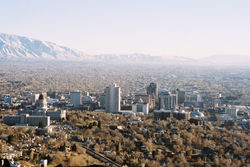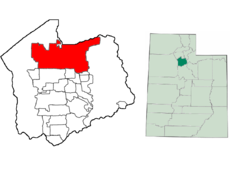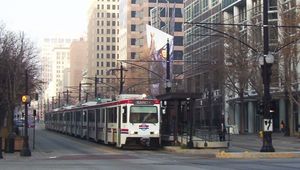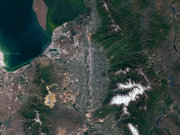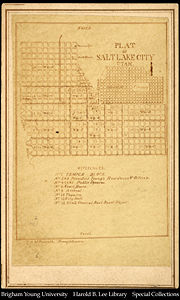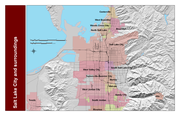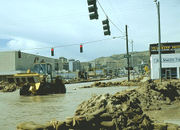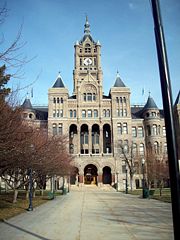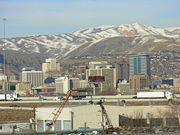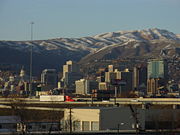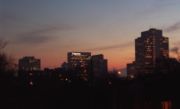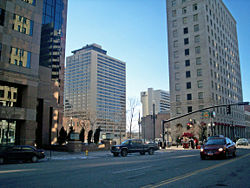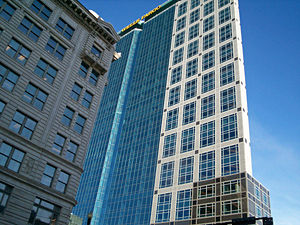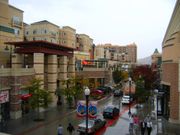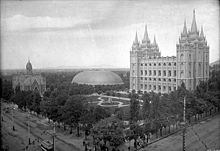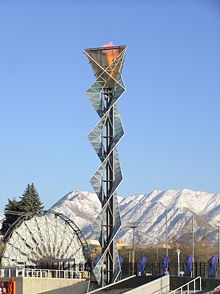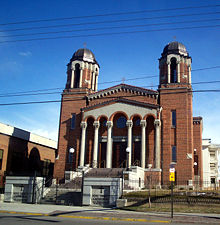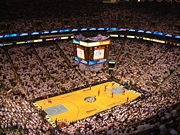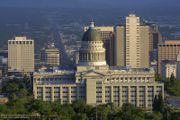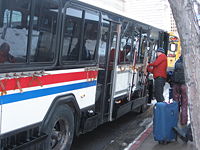Salt Lake City, Utah
2008/9 Schools Wikipedia Selection. Related subjects: Cities; North America
| City of Salt Lake City | |||
| Downtown Salt Lake City and the surrounding suburbs | |||
|
|||
| Nickname(s): Crossroads of the West, SLC | |||
| Location of Salt Lake City in Salt Lake County, Utah | |||
| Coordinates: | |||
|---|---|---|---|
| Country | United States of America | ||
| State | Utah | ||
| County | Salt Lake County | ||
| Government | |||
| - Mayor | Ralph Becker | ||
| Area | |||
| - City | 110.4 sq mi (285.9 km²) | ||
| - Land | 109.1 sq mi (282.5 km²) | ||
| - Water | 1.3 sq mi (3.3 km²) | ||
| Elevation | 4,226 ft (1,288 m) | ||
| Population (2000) | |||
| - City | 178,858 | ||
| - Density | 1,666.1/sq mi (643.3/km²) | ||
| - Urban | 887,650 | ||
| - Metro | 1,018,826 | ||
| Time zone | Mountain ( UTC-7) | ||
| - Summer ( DST) | Mountain ( UTC-6) | ||
| Area code(s) | 385/801 | ||
| FIPS code | 49-67000 | ||
| GNIS feature ID | 1454997 | ||
| Website: http://www.slcgov.com | |||
Salt Lake City is the capital and the most populous city of the U.S. state of Utah. The name of the city is often shortened to Salt Lake, or its initials, S.L.C. It was originally known as Great Salt Lake City.
Salt Lake City has a population of 178,858 as of 2006. The Salt Lake City metropolitan area spans Salt Lake, Summit and Tooele counties, and has a total estimated population of 1,018,826. Salt Lake City is further situated in a larger urban area known as the Wasatch Front, and until 2003 the Ogden-Clearfield metro area within it was considered part of the Salt Lake City metropolitan area. While Salt Lake City is only a marginal portion of the entire Salt Lake Valley, the entire valley is usually referred to as "Salt Lake City." Its population figure understates the feel of the city, since its growth has long since exceeded the city limits established in the mid-1800s. The total estimated population of the Wasatch Front is approximately 2,150,000.
The city was founded in 1847 by a group of Mormon pioneers led by their prophet, Brigham Young, who fled hostility and violence in the midwest. The headquarters of The Church of Jesus Christ of Latter-day Saints (the L.D.S. or Mormon Church) is located in the city — and, indeed, "Salt Lake City" is a metonym for this denomination's headquarters.
Mining booms and the construction of the first transcontinental railroad initially brought economic growth, and the city became nicknamed the Crossroads of the West. In the 21st century the city has developed a strong outdoor recreation tourism industry (skiing and biking), become the industrial banking centre of the U.S, and served as host to the 2002 Winter Olympics.
History
Before Mormon settlement, the Shoshone, Ute, and Paiute had dwelled in the Salt Lake Valley for thousands of years. However, these tribes dwelt only on a temporary basis near streams emptying from Canyons into the Salt Lake Valley. The first Caucasian in the Salt Lake area is believed to be the explorer Jim Bridger in 1825, although other Caucasians had been in Utah earlier, some as far north as the nearby Utah Valley. U.S. Army officer John C. Frémont surveyed the Great Salt Lake and the Salt Lake Valley in 1843 and 1845. The Donner party, a group of ill-fated pioneers, had traveled through the Great Salt Lake Valley in August 1846.
The first Europeans to settle in the valley were the Latter-day Saints on July 24, 1847. They had traveled beyond the boundaries of the United States seeking an isolated area to practice their religion, away from the hostility they had faced in the East. Upon arrival, President of the Church Brigham Young is recorded as stating, "this is the right place," later abbreviated to simply "this is the place," after reportedly seeing the area in a vision. They found the large valley empty of any human settlement.
Only four days after arriving in the Salt Lake Valley, Brigham Young designated the site for the Salt Lake Temple, intended to be the third temple of The Church of Jesus Christ of Latter-day Saints, to replace the abandoned Kirtland Temple in Ohio and Nauvoo Temple in Illinois.
Constructed on Temple Square, in the centre of the city, the temple took 40 years to complete, being started in 1853 and dedicated on April 6, 1893. These delays meant that temples in St. George, Logan and Manti were completed before the Salt Lake Temple The temple has become iconic of the city and is the centerpiece of the city. In fact, the southeast corner of Temple Square is the initial point of reference point for the Salt Lake Meridian, and for all addresses in the Salt Lake Valley.
The Mormon pioneers organized a new state called Deseret and petitioned for its recognition in 1849. The United States Congress rebuffed the settlers in 1850 and established the Utah Territory, vastly reducing its size. Great Salt Lake City replaced Fillmore as the territorial capital in 1858, and the name was subsequently abbreviated to Salt Lake City. The city's population swelled with an influx of religious converts, making it one of the most populous cities in the American Old West.
Disputes with the federal government ensued over the widespread Mormon practice of polygamy. A climax occurred in 1857 when President James Buchanan declared the area in rebellion after Brigham Young refused to step down as governor, beginning the Utah War. A division of the United States Army, commanded by Albert Sidney Johnston, later a general in the army of the Confederate States of America, marched through the city and found that it had been evacuated. This division set up Camp Floyd approximately 40 miles (65 km) southwest of the city. Another military installation, Fort Douglas, was established in 1862 to maintain Union allegiance during the American Civil War. Many area leaders were incarcerated at the territorial prison in Sugar House in the 1880s for violation of anti-polygamy laws. The LDS Church began their eventual abandonment of polygamy in 1890, releasing "The Manifesto," which officially suggested that members obey the law of the land (which was equivalent to forbidding new polygamous marriages inside the U.S. and its territories, but not in Mormon settlements in Canada and Mexico). This paved the way for statehood in 1896, when Salt Lake City became the state capital.
The First Transcontinental Railroad was completed in 1869 at Promontory Summit on the north side of the Great Salt Lake. A railroad was connected to the city from the Transcontinental Railroad in 1870, making travel less burdensome. Mass migration of different groups followed. They found economic opportunities in the booming mining industries. These groups constructed St. Mark's Episcopal Cathedral in 1874, the Greek Orthodox Holy Trinity Cathedral in 1905 and the Roman Catholic Cathedral of the Madeleine in 1909. This time period also saw the creation of Salt Lake City's now defunct Red-light district that employed 300 courtesans at its height before being closed down in 1911.
During the late 19th and early 20th centuries, an extensive streetcar system was constructed throughout the city with the first streetcar running in 1872 and electrification of the system in 1889. As in the rest of the country, the automobile usurped the streetcar and the last trolley ran in 1945. Rail transit was re-introduced when TRAX, a light rail system, opened in 1999.
The city's population began to stagnate during the 20th century as population growth shifted to suburban areas north and south of the city. Few of these areas were annexed to the city, while nearby towns incorporated and expanded themselves. As a result, the population of the surrounding metropolitan area greatly outnumbers that of Salt Lake City. A major concern of recent government officials has been combating inner-city commercial decay. The city lost population from the 1960s through the 1980s, but experienced some recovery in the 1990s. Presently, the city is losing population again (though that of the metro area continues to grow), having lost an estimated 2 percent of its population since the year 2000.
The city has experienced significant demographic shifts in recent years. Hispanics now account for approximately 19% of residents and the city has a large gay community. There is also a large Pacific Islander population, mainly made up of Samoans and Tongans; they compose roughly 1% of the population of the Salt Lake Valley area.
Salt Lake City was selected to host the 2002 Winter Olympics in 1995. The games were plagued with controversy. A bid scandal surfaced in 1998 alleging that bribes had been offered to secure the city for the 2000 games location. During the games, other scandals erupted over contested judging scores and illegal drug use. Despite the controversies, the games were heralded as a financial success, being one of the few in recent history to profit. In preparation major construction projects were initiated. Local freeways were expanded and repaired, and a light rail system was constructed. Olympic venues are now used for local, national, and international sporting events and Olympic athlete training. Tourism has increased since the Olympic games, but business did not pick up immediately following them.
Salt Lake City hosted the 16th Winter Deaflympic games in 2007, taking place in the venues in Salt Lake City and Park City, and Rotary International has designated the city as the site of their 2007 convention, which will be the largest single gathering since the 2002 Winter Olympics. The U.S. Volleyball Association convention in 2005 drew 39,500 attendees.
Geography
Salt Lake City is located at . The total area is 110.4 square miles (285.9 km²) and has an average elevation of 4,327 feet (1,320 m) above sea level. The lowest point within the boundaries of the city is 4,210 feet (1,280 m) near the Jordan River and the Great Salt Lake, and the highest is Grandview Peak, at 9,410 foot (2,868 m).
The city is located in the northeast corner of the Salt Lake Valley surrounded by the Great Salt Lake to the northwest and the steep Wasatch and Oquirrh mountain ranges on the eastern and western borders, respectively. Its encircling mountains contain many narrow glacially and volcanically carved canyons. Among them, City Creek, Emigration, Millcreek, and Parley's border Salt Lake City proper.
The Great Salt Lake is separated from Salt Lake City by extensive marshlands and mudflats. The metabolic activities of bacteria in Willard Bay (the freshwater portion of the lake) results in a phenomenon known as "lake stink", a scent reminiscent of foul poultry eggs, two to three times per year for a few hours. The Jordan River flows through the city and is a drainage of Utah Lake that empties into the Great Salt Lake.
The highest mountaintop visible from Salt Lake City is Twin Peaks, which reaches 11,489 feet (3502 m). Twin Peaks is located southeast of Salt Lake in the Wasatch Range. The Wasatch Fault is found along the western base of the Wasatch and is considered overdue for an earthquake as large as 7.5. Catastrophic damage is predicted in the event of an earthquake with major damage resulting from the liquefaction of the clay- and sand-based soil and the possible permanent flooding of portions of the city by the Great Salt Lake.
The second-highest mountain range is the Oquirrhs, reaching a maximum height of 10,620 feet (3,237 m) at Flat Top. The Traverse Mountains to the south extend to 6,000 feet (1,830 m), nearly connecting the Wasatch and Oquirrh Mountains. The mountains near Salt Lake City are easily visible from the city and have sharp vertical relief caused by massive ancient earthquakes, with a maximum difference of 7,099 feet (2164 m) being achieved with the rise of Twin Peaks from the Salt Lake Valley floor.
The Salt Lake Valley floor is the ancient lakebed of Lake Bonneville which existed at the end of the last Ice Age. Several Lake Bonneville shorelines can be distinctly seen on the foothills or benches of nearby mountains .
Layout
The city, as well as the county, is laid out on a grid plan; Most major streets run very nearly north-south and east-west. There is about a fourteen to fifteen minute of arc variation of the grid from true north. The grid's origin is the southeast corner of Temple Square, the block containing the Salt Lake Temple of the Church of Jesus Christ of Latter-day Saints. Addresses are coordinates within the system (similarly to latitude and longitude). One hundred units are equal to 1/8th of a mile (200 m), the length of blocks in downtown Salt Lake City. The streets are relatively wide, at the direction of Brigham Young, who wanted them wide enough that a wagon team could turn around without "resorting to profanity." These wide streets and grid pattern are typical of other Mormon towns of the pioneer era throughout the West.
Though the nomenclature may initially confuse new arrivals and visitors, many consider the grid system an aid to navigation. Some streets have names, such as State Street, which would otherwise be known as 100 East. Other streets have honorary names, such as the western portion of 300 South, named "Adam Galvez Street" (in honour of a local Marine corporal killed in action) or others honoring Rosa Parks, Martin Luther King, Jr., and César Chávez. These honorary names appear only on street signs and cannot be used in postal addresses.
In The Avenues neighbourhood, north-south streets are given letters of the alphabet, and east-west streets are numbered in 2.5 acre (10,100 m²) blocks, smaller than those in the rest of the city.
Joseph Smith, founder of The Church of Jesus Christ of Latter-day Saints, planned the layout in the " Plat of the City of Zion" (intended as a template for Mormon towns wherever they might be built). In his plan the city was to be developed into 135 10 acre lots. However, the blocks in Salt Lake City became irregular during the late 19th century when the LDS Church lost authority over growth and before the adoption of zoning ordinances in the 1920s. The original 10 acre blocks allowed for large garden plots, and many were supplied with irrigation water from ditches that ran approximately where modern curbs and gutters would be laid. The original water supply was from City Creek. Subsequent development of water resources was from successively more southern streams flowing from the mountains to the east of the city. Some of the old irrigation ditches are still visible in the eastern suburbs, or are still marked on maps, years after they were gone.
Neighborhoods
Salt Lake City has many informal neighborhoods. The eastern portion of the city has higher property values than its western counterpart. This is a result of the railroad being built in the western half as well as scenic views from inclined grounds in the eastern portion. Housing is more affordable on the west side, which results in demographic differences. Interstate 15 was also built in a north-south line, further dividing east and west sides of the city.
The west side of the city has historically been a working-class neighborhood, but recently the more affordable nature of the area has enticed many professionals to the neighbourhood. For example, the small, increasingly trendy Marmalade District on the west side of Capitol Hill, once considered seedy as few as 5–10 years ago, was heavily gentrified and is now thought of as an eclectic and desirable location. During the 1980s, gang activity was also centered in the western neighborhoods of Rose Park, Poplar Grove, and Glendale.
Sugar House, in southeastern Salt Lake City, has a reputation as a liberal neighbourhood and until recently possessed a district of locally-owned specialty and niche shops on the corner of 2100 South and 1100 East. The stores that once occupied the street have recently moved to new locations to make way for a condominium and office complex, although the developers have stated that they wish to maintain the character of the area, and retail shops will be allowed at street-level once the complex is completed. Despite these assurances, residents have been very vocal in their concerns that the neighbourhood will lose its unique eclectic appeal and have panned what they call the destruction of one of the few locally-owned business districts in the valley.
Just northeast of Downtown is The Avenues, a neighbourhood outside of the regular grid system on much smaller blocks. This area is a Historical District that is nearly entirely residential, and contains many historical Victorian era homes. The Avenues are situated on the upward-sloping bench in the foothills of the Wasatch Range, with the earlier built homes in the lower elevation. The Avenues, along with Federal Heights, just to the east and north of the University of Utah, and the Foothill area, south of the University, contain gated communities, large, multi-million dollar houses, and fantastic views of the valley. Many consider this some of the most desirable real estate in the valley.
In addition to larger centers like Sugar House and Downtown, Salt Lake City contains several smaller neighborhoods, each named after the closest major intersection. Two examples are the 9th and 9th (located at the intersection of 900 East and 900 South Streets) and 15th & 15th (located at the intersection of 1500 East and 1500 South Streets) neighborhoods. These areas are home to foot-traffic friendly, amenities-based businesses such as art galleries, clothing retail, salons, restaurants and coffee shops. During the summer of 2007, 9th and 9th saw sidewalk and street improvements as well as an art installation inspired by the 9 Muses of Greek myth, thanks in part to the 9th and 9th Merchants Association.
Many of the homes in the valley date from pre-World War II times, and only a select few areas, such as Federal Heights and the East Bench, as well as the far west side, including parts of Rose Park and Glendale, have seen new home construction since the 1970s.
Climate
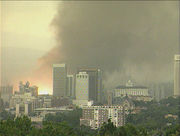
The climate of Salt Lake City is characterized as a semi-arid steppe climate (Köppen Bsk), with four distinct seasons. Both summer and winter are long, with hot, dry summers and cold, snowy winters, and with spring and fall serving as brief but comfortable transition periods. The city receives 16.50 in (419 mm) of precipitation annually. Spring is the wettest season, and another "rainy season" occurs in fall. Snow occurs on average from November 6 to April 18, producing a total average of 62.7 in (159 cm), while the city's watersheds in nearby mountains accumulate averages as high as 500 in (1,270 cm). The period without freezing temperatures usually lasts an average of 167 days, from April 30 to October 15.
During the winter months cold fronts typically originate in the Gulf of Alaska and move southeastward into the area. The nearby Great Salt Lake produces lake-effect snow approximately 6 to 8 times per year, some of which can drop excessive snowfalls. The lake-effect also contributes to some rain storms, and it is estimated that about 10% of the annual precipitation in the city can be attributed to the lake effect. During mid-winter, strong areas of high pressure often situate themselves over the Great Basin, leading to strong temperature inversions. This causes air stagnation and thick smog in the valley for several days to weeks at a time and can result in the worst air-pollution levels in the U.S. reducing air quality to unhealthy levels. The city has an average of three days annually with low temperatures below 0 °F (−18 °C), with an all-time record low temperature of -30 °F (-34 °C), which occurred on February 9, 1933.
In the spring, most of the storms originate in the Pacific Ocean from the Pineapple Express, bringing in the most moisture of the entire year. Larger and cooler storms in the spring can lead to heavy overnight snowfall. Measurable snow has occurred as late as May 18.
The summers of the city are marked by hot weather and are mostly dry. The monsoon rises from the Gulf of California from approximately mid-July into September, producing localized severe afternoon thunderstorms. Due to the low daytime humidity, virga, lightning, and microbursts can lead to wildfire problems. During active monsoon periods, widespread thunderstorms carrying excessive precipitation are common. High temperatures of at least 100 °F (38 °C) occur on average five times a year, but always on days with low humidity. The record high temperature is 107 °F (42 °C), which occurred first on July 26, 1960 and again on July 13, 2002.
During October, the Pacific Ocean once again becomes active, bringing in more precipitation, occasionally in the form of the remnants of tropical cyclones. The remnants of Hurricane Olivia helped bring the record monthly precipitation of 7.04 in (179 mm) in September 1982. The first measurable snowfall has occurred as early as September 17.
| Weather averages for Salt Lake City | |||||||||||||
|---|---|---|---|---|---|---|---|---|---|---|---|---|---|
| Month | Jan | Feb | Mar | Apr | May | Jun | Jul | Aug | Sep | Oct | Nov | Dec | |
| Record high °F (°C) | 63 (17) | 69 (21) | 78 (26) | 89 (32) | 99 (37) | 104 (40) | 107 (42) | 106 (41) | 100 (38) | 89 (32) | 75 (24) | 69 (21) | |
| Average high °F (°C) | 37 (3) | 43 (6) | 53 (12) | 61 (16) | 71 (22) | 82 (28) | 91 (33) | 89 (32) | 78 (26) | 64 (18) | 49 (9) | 38 (3) | |
| Average low °F (°C) | 21 (-6) | 26 (-3) | 33 (1) | 39 (4) | 47 (8) | 56 (13) | 63 (17) | 62 (17) | 52 (11) | 41 (5) | 30 (-1) | 22 (-6) | |
| Record low °F (°C) | -22 (-30) | -30 (-34) | 2 (-17) | 14 (-10) | 25 (-4) | 35 (2) | 40 (4) | 37 (3) | 27 (-3) | 16 (-9) | -14 (-26) | -21 (-29) | |
| Source: Data is for Salt Lake International Airport | |||||||||||||
|
|
|
Jan | Feb | Mar | Apr | May | Jun | Jul | Aug | Sep | Oct | Nov | Dec |
|---|---|---|---|---|---|---|---|---|---|---|---|---|---|
| Record Precipitation | in. | 3.23 | 4.89 | 3.97 | 4.90 | 4.76 | 3.84 | 2.57 | 3.66 | 7.04 | 3.91 | 3.34 | 4.37 |
| Average Precipitation | in. | 1.37 | 1.33 | 1.91 | 2.02 | 2.09 | 0.77 | 0.72 | 0.76 | 1.33 | 1.57 | 1.40 | 1.23 |
| Average Snowfall | in. | 13.6 | 9.9 | 9.1 | 4.9 | 0.6 | 0.0 | 0.0 | 0.0 | 0.1 | 1.3 | 7.0 | 12.0 |
| Record Snowfall | in. | 50.3 | 32.1 | 41.9 | 26.4 | 7.5 | 0.0 | 0.0 | 0.0 | 4.0 | 20.4 | 33.3 | 35.2 |
| Data is for Salt Lake International Airport | |||||||||||||
Demographics
As of the census of 2000, there are 181,743 people (up from 159,936 in 1990), 71,461 households, and 39,803 families residing in the city. This amounts to 8.1% of Utah's population, 20.2% of Salt Lake County's population, and 13.6% of the Salt Lake metropolitan population. Salt Lake City proper covers 14.2% of Salt Lake County. Salt Lake City is more densely populated than the surrounding metro area with a population density of 643.3/km² (1,666.1/sq mi). There are 77,054 housing units at an average density of 706.4/sq mi (272.7/km²).
The Salt Lake City- Ogden metropolitan area, which included Salt Lake, Davis, and Weber counties, had a population of 1,333,914 in 2000, a 24.4% increase over the 1990 figure of 1,072,227. Since the 2000 Census, the Census Bureau has added Summit and Tooele counties to the Salt Lake City metropolitan area, but removed Davis and Weber counties and designated them as the separate Ogden- Clearfield metropolitan area. Together with the Provo- Orem metropolitan area, which lies to the south, it has a combined population of well over 2 million.
There are 71,461 households, out of which 27.0% have children under the age of 18 living with them, 41.1% are married couples living together, 10.2% have a female householder with no husband present, and 44.3% are nonfamilies. Of the 71,461 households, 3,904 were reported to be unmarried partner households: 3,047 heterosexual, 458 same-sex male, and 399 same-sex female. 33.2% of all households are made up of individuals, and 9.7% have someone living alone who is 65 years of age or older. The average household size is 2.48, and the average family size is 3.24.
In the city the population is spread out with:
- 23.6% under the age of 18
- 15.2% from 18 to 24
- 33.4% from 25 to 44
- 16.7% from 45 to 64
- 11.0% who are 65 years of age or older
The median age is 30 years. For every 100 females there are 102.6 males. For every 100 females age 18 and over, there are 101.2 males. The median income for a household in the city is $36,944, and the median income for a family is $45,140. Males have a median income of $31,511 versus $26,403 for females. The per capita income for the city is $20,752. 15.3% of the population and 10.4% of families are below the poverty line. Out of the total population, 18.7% of those under the age of 18 and 8.5% of those 65 and older are living below the poverty line.
| Historical populations | |||
|---|---|---|---|
| Census | Pop. | %± | |
| 1860 | 8,236 |
|
|
| 1870 | 12,854 | 56.1% | |
| 1880 | 20,768 | 61.6% | |
| 1890 | 44,843 | 115.9% | |
| 1900 | 53,531 | 19.4% | |
| 1910 | 92,777 | 73.3% | |
| 1920 | 116,110 | 25.1% | |
| 1930 | 140,267 | 20.8% | |
| 1940 | 149,934 | 6.9% | |
| 1950 | 182,121 | 21.5% | |
| 1960 | 189,454 | 4% | |
| 1970 | 175,885 | −7.2% | |
| 1980 | 163,034 | −7.3% | |
| 1990 | 159,936 | −1.9% | |
| 2000 | 181,743 | 13.6% | |
| Est. 2006 | 178,858 | −1.6% | |
Large family sizes and low housing vacancy rates, which have inflated housing costs along the Wasatch Front, have led to one out of every six residents living below the poverty line.
Less than 50% of Salt Lake City's residents are members of The Church of Jesus Christ of Latter-day Saints. This is a much lower proportion than in Utah's more rural municipalities; altogether, LDS members make up about 62% of Utah's population.
The Rose Park and Glendale sections are predominantly Spanish-speaking with Latinos accounting for 60% of public school-children. The Centro Civico Mexicano acts as a community gathering point for the Wasatch Front's estimated 300,000 Latinos, Mexican President Vicente Fox began his U.S. tour in the city in 2006, and the largest supermarket chain of Mexico, Supermercados Gigante, is planning a location, the first in the U.S. outside of California. Bosnian, Sudanese, Afghani, Bantu, and Russian refugees have settled in the city under government programs. There is also a large Pacific Islander population, mainly made up of Samoans and Tongans. Many of the Pacific Islanders are members of the LDS Church.
Salt Lake City has been considered one of the top 51 "gay-friendly places to live" in the U.S. The city is home to a large, business savvy, organized, and politically supported gay community. Leaders of the Episcopal Church's Diocese of Utah, Utah's largest Jewish congregation, the Salt Lake Kol Ami, and three elected representatives of the city, two members of the state house and one in the senate, all describe themselves as gay friendly. These developments have attracted controversy from socially conservative officials representing other regions of the state. State Senator Chris Buttars of West Jordan publicly denounced former Mayor Rocky Anderson for having "attracted the entire gay community to come and live in Salt Lake County" after a Dan Jones poll indicated strong support for allowing domestic partnerships. In the 2004 election, 63% of the city population voted against banning same-sex marriage, in agreement with Mayor Anderson.
In 2007 Salt Lake City was also surprisingly ranked by Forbes Magazine as the most vain city in America.
Economy
The modern economy of Salt Lake City is service-oriented. In the past, nearby steel, mining and railroad operations provided a strong source of income with Silver King Coalition Mines, Geneva Steel, Bingham Canyon Mine, and oil refineries. Today the city's major industries are government, trade, transportation, utilities, and professional and business services. The city is known as the "Crossroads of the West" for its central geography in the western United States. As a result, Interstate 15 is a major corridor for freight traffic and the area is host to many regional distribution centers.
Local, state, and federal governments have their largest presence in the city proper itself, and trade, transportation, and utilities also take up a significant portion of employment, with the major employer being the western North America Delta Air Lines hub at Salt Lake City International Airport. Equally significant are the professional and business services, while health services and health educational services also serve as significant areas of employment. Other major employers include the University of Utah, Sinclair Oil Corporation, and The Church of Jesus Christ of Latter-day Saints.
Besides its central offices, the LDS Church owns and operates a profit division, Deseret Management Corporation and its subsidiaries, which are headquartered in the city. Other notable firms headquartered in the city include AlphaGraphics, Sinclair Oil Corporation, Zions Bancorporation, Smith's Food and Drug (owned by national grocer Kroger). Notable firms based in the metropolitan area include Arctic Circle Restaurants, Franklin-Covey, and Overstock.com. Metropolitan Salt Lake was also once the headquarters of Kentucky Fried Chicken (the first ever KFC is located in South Salt Lake), American Stores, the Skaggs Companies, and ZCMI, one of the first-ever department stores; it is currently owned by Federated Department Stores. Former ZCMI stores now operate under the Macy's label. Suburban Salt Lake was also the first location for Sears Grand (at the Jordan Landing shopping centre in West Jordan).
Since Utah is one of seven states that allow the establishment of commercially-owned industrial banks, the vast majority of industrial banks in the U.S. have established their headquarters in the Salt Lake City area. High-tech firms with a large presence in the suburbs include e-Bay, Unisys, Siebel, Micron, L-3 Communications and 3M.
Other economic activities include tourism, conventions, and major suburban call centers. Tourism has increased since the 2002 Olympic Winter Games, and many hotels and restaurants were built for the events. The convention industry has expanded since the construction of the Salt Palace convention centre in the late 1990s, which hosts trade shows and conventions, including the annual Outdoor Retailers meeting and Novell's annual BrainShare convention.
In 2006, the largest potato producer in Idaho, the United Potato Growers of America, announced that it would re-locate its headquarters to Salt Lake City, citing its need for a large international airport, being that Salt Lake City International is the 22nd busiest in the world in terms of combined freight and passengers. The announcement led some members of the Idaho legislature to propose legislation changing the state license plate, which currently reads "Famous Potatoes".
In 2005, it was found the downtown area was experiencing rapid population growth. The number of residential units in the central business district has increased by 80% since 1995, and is forecast to nearly double in the next decade. The City Creek development of the LDS Church will be adding 300 units in its first phase including the 415 ft (126 m). tall City Creek condominium tower, Allen Millo Associates currently has two projects under construction and two more planned, all 200 units have been sold before construction of a seven-story condominium planned by Wood Property, a residential tower is planned for Trolley Square, and this is after the recent completion of the Northgate Apartments and 12-story condominiums at Gateway with two more buildings finished nearby and the Liberty Metro apartments near Library Square.
Office vacancy rates are low in the downtown region. In response, two new large buildings are being constructed. The first is eight stories and located in the Gateway District, while the second will be 22 stories high and is currently under construction on Main Street. In addition, the historic Walker Bank Building is currently undergoing major renovations that will enable it to achieve Class A office space status. Construction of the Gateway District, light rail, and planned commuter rail service have supported the revival of downtown.
Law and government
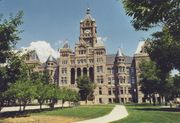
Since 1979 Salt Lake City has had a nonpartisan mayor-council form of government. The mayor and the seven councilors are elected to four-year terms. Mayoral elections are held the same year as three of the councilors. The other four councilors are staggered two years from the mayoral. Council seats are defined by geographic population boundaries. Each councilor represents approximately 26,000 citizens. Officials are not subject to term limits. The most recent election was held in 2007.
The city has elected Democratic Party mayoral candidates since the 1970s. Councilors are elected under specific issues and are usually well-known. Labor politics play no significant role. The city has two elected openly gay women and an openly gay man, representing the city in the State House and Senate, respectively.
The separation of church and state was the most heated topic in the days of the Liberal Party and People's Party of Utah, when many candidates would be LDS Bishops and Mark Twain referred to Brigham Young as "the only monarch in America." This tension is still reflected today with the Bridging the Religious Divide campaign. This campaign was initiated when some city residents complained that the Utah political establishment was unfair in its dealings with non-LDS residents by giving the LDS Church preferential treatment, while LDS residents perceived a growing anti-Mormon bias in city politics.
The city's political demographics are liberal and Democratic. This stands in stark contrast to the majority of Utah where Republican and conservative views generally dominate.
The city is home to several non-governmental think-tanks and advocacy groups such as the conservative Sutherland Institute, the gay-rights group Equality Utah, and the quality-growth advocates Envision Utah. Salt Lake hosted many foreign dignitaries during the 2002 Winter Olympics, and in 2006 the President of Mexico began his U.S. tour in the city and Israel's ambassador to the United States opened a cultural centre. President George W. Bush visited in 2005 and again in 2006 for national veterans' conventions, both visits of which were protested by then-Mayor Rocky Anderson. Other political leaders such as Howard Dean and Harry Reid gave speeches in the city in 2005.
Education
In 1847 pioneer Jane Dillworth held the first classes in her tent for the children of the first LDS families. In the last part of the 1800s, there was much controversy over how children in the area should be educated. LDS and non-LDS could not agree on the level of religious influence in schools. Today, many LDS youths in grades 9 through 12 attend some form of religious instruction, referred to as seminary.
Because of high birth rates and large classrooms, Utah spends less per student than any other state yet simultaneously spends more per capita than any state with the exception of Alaska. Money is always a challenge, and many businesses donate to support schools. Several districts have set up foundations to raise money. Recently, money was approved for the reconstruction of more than half of the elementary schools and one of the middle schools in the Salt Lake City School District, which serves most of Salt Lake City proper. There are twenty-three elementary schools, five middle schools, three high schools (Highland, East, and West, with the former South High being converted to the South City campus of the Salt Lake Community College), and an alternative high school (Horizonte) located within the school district. In addition, Highland has recently been selected as the site for the charter school Salt Lake School for the Performing Arts (SPA), while Salt Lake City proper also holds many Catholic schools, including Judge Memorial High School. Rowland Hall-St. Mark's School, established in 1867 by Episcopal Bishop Daniel Tuttle, is the area's premier independent school.
The Salt Lake City Public Library system consists of the main library downtown, and five branches in various neighborhoods. The main library, designed by renowned architect Moshe Safdie, opened in 2003. In 2006, the Salt Lake City Public Library was named "Library of the Year" by the American Library Association.
Postsecondary educational options in Salt Lake City include the University of Utah, Westminster College, Salt Lake Community College, BYU Salt Lake Centre, Eagle Gate College, and LDS Business College. There are also many trade and technical schools such as Healing Mountain Massage School and the Utah College of Massage Therapy.
Culture
Museums and the Arts
Salt Lake is home to several museums. Near Temple Square is the Museum of Church History and Art. Operated by the The Church of Jesus Christ of Latter-day Saints, the museum contains collections of artifacts, documents, art, photographs, tools, clothing and furniture from the history of the LDS Church, which spans nearly two centuries.
The University of Utah campus is home to the Utah Museum of Fine Arts as well as the Utah Museum of Natural History. West of the university, located at the Gateway District near downtown, is the Clark Planetarium, which also houses an IMAX theatre. Also in the Gateway District is the Discovery Gateway, a children's museum.
Other museums include the Utah State Historical Society, Daughters of Utah Pioneer Memorial Museum, Fort Douglas Military Museum, and the Social Hall Heritage Museum.
On December 5, 2007, the Salt Lake Chamber and Downtown Alliance announced that a two-block section of downtown south of the planned City Creek Centre is planned to become a new arts hub. This will include renovations to two theaters already located in the area, as well as a new theater with a seating capacity of 2,400 and increased space for galleries and artists. The opening of the new facilities are anticipated to coincide with the opening of the City Creek Centre in 2011.
Performing Arts
Salt Lake City provides many venues for both professional and amateur theatre. The city attracts many traveling Broadway and off-Broadway performances. Local professional acting companies include the Pioneer Theatre Company, Salt Lake Acting Company, and Plan-B Theatre Company. The Off Broadway Theatre, located in Salt Lake's historic Clift Building, features comedy plays and Utah's longest running improv comedy troupe, Laughing Stock.
Salt Lake City is the home of the Mormon Tabernacle Choir, founded in 1847. The Choir's weekly program, called Music and the Spoken Word, is the longest-running continuous network broadcast in the world. Salt Lake City is also the home to the Utah Symphony Orchestra, which was founded in 1940 by Maurice Abravanel and has become widely renowned. Its current director is Keith Lockhart. The orchestra's original home was the Salt Lake Tabernacle, but since the 1990s has performed at Abravanel Hall in the western downtown area. Salt Lake City area is also home to the award winning children's choir, The Salt Lake Children's Choir. The Choir was established in 1979 and is directed by Ralph B. Woodward.
The University of Utah is home to two highly-ranked dance departments, the Ballet Department and the Department of Modern Dance. Professional dance companies in Salt Lake City include Ballet West, Rire Woodbury, and Repertory Dance Theatre.
Music Scene
The city has a local music scene dominated by blues, rock and roll, punk, and emo groups. There are also many clubs which offer musical venues. Popular groups or persons who started in the Wasatch Front area or were raised and influenced by it include The Used, Shedaisy, Meg and Dia, The Almost, The Brobecks and The Summer Obsession. In 2004 over 200 bands submitted tracks for a compilation by a local music zine, SLUG ("Salt Lake Underground"). The 18-year-old free monthly zine trimmed the submissions to 59 selections featuring diverse music types such as hip-hop, jazz, jazz-rock, punk, and a variety of rock and roll.
Movies and Television
Many films, music videos, commercials, and TV shows have been recorded in the Salt Lake metropolitan area. They include: SLC Punk!, Touched By An Angel, Everwood, Big Love, Dawn of the Dead, Drive Me Crazy, Forever Strong, High School Musical, High School Musical 2, High School Musical 3, Unaccompanied Minors, Dumb and Dumber, Halloween 4, Halloween 5, Halloween 6, Independence Day, Poolhall Junkies, The Brown Bunny, The World's Fastest Indian, The Way of the Gun, Carnival of Souls, The Amazing Race 8, and The Postal Service's " Such Great Heights". In 2006 it was revealed that Dan Brown, the author of The DaVinci Code, was in the city studying the symbols on the Salt Lake LDS Temple and the Salt Lake Masonic Temple, among other historical buildings, for inclusion in an upcoming book.
Events
Although the city is often stereotyped as a predominantly LDS city, it is culturally and religiously diverse. The city is the location of many cultural activities. A major state holiday is Pioneer Day, July 24, the anniversary of the Mormon pioneers' entry into the Salt Lake Valley. It is celebrated each year with a week's worth of activities, including a children's parade, a horse parade, the featured Days of '47 Parade (one of the largest parades in the United States), a rodeo, and a large fireworks show at Liberty Park.
Salt Lake City has a significant gay population, and the second-largest parade in the city is a gay pride parade, part of the annual Utah Pride Festival held every June.
First Night on New Year's Eve, a celebration emphasizing family-friendly entertainment and activities held at Rice-Eccles Stadium at the University of Utah, culminates with a fireworks display at midnight.
The Greek Festival, held the weekend after Labor Day, celebrates Utah's Greek heritage and is located at the downtown Greek Orthodox Church. The 3-day event includes Greek music, dance groups, Cathedral tours, booths and a large buffet. Attendance ranges from 35,000 - 50,000.
The Utah Arts Festival has been held annually since 1977 with an average attendance of 80,000. About 130 booths are available for visual artists and there are five performance venues for musicians.
Salt Lake City also hosts portions of the Sundance Film Festival. The festival, which is held each year, brings many cultural icons, movie stars, celebrities, and thousands of film buffs to see the largest independent film festival in the United States. The headquarters of the event is in nearby Park City.
Beginning in 2004, Salt Lake City has been the host of the international Salt Lake City Marathon. In 2006 Real Madrid and many of the nation's best cyclist had engagements.
Salt Lake City has begun to host its own events in the last few years, most notably the Friday Night Flicks, free movies in the City's parks, as well as the Mayor's health and fitness awareness program, Salt Lake City Gets Fit.
Salt Lake City was host to the 2002 Winter Olympics. At the time of the 2002 Olympics, Salt Lake City was the most populated area to hold a Winter Olympic games. The event put Salt Lake City in the international spotlight and is regarded by many as being one of the most successful winter olympics ever.
To add variety and an international taste to the music fans, events such as the annual Thyagaraja Music Festival of Utah are held in Salt Lake City.
At Dream Theatre's Salt Lake City show, Governor Jon Huntsman, Jr. signed a proclamation making July 30, 2007 "Dream Theatre Day" in the state of Utah.
Beginning in 2005, annual Nihon Matsuri (Japan Festival) is opened at Salt Lake City.
Sites of interest and city architecture
Salt Lake City is the headquarters for The Church of Jesus Christ of Latter-day Saints (LDS Church) and has many LDS-related sites open to visitors. The most popular is Temple Square, which includes the Salt Lake Temple and visitors’ centers that are open to the public, free of charge. Temple Square also includes the historic Tabernacle, home of the world-famous Mormon Tabernacle Choir. The modern LDS Conference Centre is across the street to the north. The Family History Library, the largest genealogical library in the world, is located just west of Temple Square. It is run by the LDS Church and is open to the public and free of charge.
In 2004, the Salt Lake City main library received an Institute Honour Award for Architecture by the American Institute of Architects. and features a distinctive architectural style. The roof of the building serves as a viewpoint for the Salt Lake Valley. The Utah State Capitol Building offers marble floors and a dome similar to that of the building that houses the U.S. Congress. Other notable historical buildings include the Thomas Kearns Mansion (now the Governor's Mansion), City and County Building, built in 1894, the Kearns Building on Main Street and the Roman Catholic Cathedral of the Madeleine, built in 1909.
Near the mouth of Emigration Canyon lies This Is The Place Heritage Park, which re-creates typical 19th century LDS pioneer life. Hogle Zoo is located across the street from the park. The city’s largest public park, at over 100 acres (0.40 km²), Liberty Park features a lake with an island in the middle and the Tracy Aviary. The park is home to a large number of birds, both wild and in the aviary. Red Butte Garden and Arboretum, located in the foothills of Salt Lake features many different exhibits and also hosts many musical concerts. The Bonneville Shoreline Trail is a popular hiking and biking nature trail which spans ninety miles through the foothills of the Wasatch Front.
The Olympic Cauldron Park, located at Rice-Eccles Stadium, features the Olympic Cauldron from the games, a visitor's centre, and the Hoberman Arch. The Olympic Legacy Plaza, located at the Gateway District, features a dancing fountain set to music and the names of 30,000 Olympic volunteers carved in stone. The Utah Olympic Park, located near Park City, features the Olympic ski jumps, as well as bobsleigh, luge, and skeleton runs. Today, the Olympic Park is used for year-round training and competitions. Visitors to the park can watch the various events that occur and even ride a bobsled. The Utah Olympic Oval, located in nearby Kearns, was home to the speed skating events and is now open to the public. Other popular Olympic venues include Soldier Hollow, the site of cross-country skiing events, located southeast of Salt Lake near Heber City.
Salt Lake City is in close proximity to several world-class ski and summer resorts, including Park City Mountain Resort, Deer Valley, and Snowbird. The resorts cater to millions of visitors each year and offer year-round activities.
Salt Lake City is also home to a few major shopping centers. Trolley Square is an indoor and outdoor mall with many independent art boutiques, restaurants, and national retailers. The buildings housing the shops are renovated trolley barns with cobblestone streets. The Gateway District, an outdoor shopping mall, is the city’s newest major shopping center and has many national restaurants, clothing retailers, a movie theatre, the Clark Planetarium, the Discovery Gateway, a music venue called The Depot, and the Olympic Legacy Plaza.
On October 3, 2006, the LDS Church, who owns the ZCMI Centre Mall and Crossroads Mall, both on Main Street, announced plans to demolish the malls, a skyscraper, and several other buildings to make way for the $1 billion City Creek Centre redevelopment. It will combine several new office and residential buildings (one of which will be the third-tallest building in the city) around an outdoor shopping centre featuring a stream, fountain, and other outdoor amenities, and is expected to be completed in 2011. Sugar House is a neighbourhood with a small town main street shopping area and numerous old parks. Sugar House Park is the second largest park in the city, and is host to frequent outdoor events and the primary Fourth of July fireworks in the city.
Other attractions in or within close proximity to Salt Lake City include the Golden Spike National Historic Site (where the world's first transcontinental railroad was joined), the Lagoon Amusement Park, the Great Salt Lake, the Bonneville Salt Flats, Gardner Historic Village, one of the largest dinosaur museums in the U.S. at Thanksgiving Point in Lehi, and the world’s largest man-made excavation at Bingham Canyon Mine.
Sports and recreation
Winter sports, such as skiing and snowboarding, are popular activities in the Wasatch Mountains east of Salt Lake City. Eight ski resorts lie within 50 miles (80 km) of the city. Alta, Brighton, Solitude Mountain Resort, and Snowbird are located in Big and Little Cottonwood Canyons to the southeast, Deer Valley, The Canyons, and Park City Resort are located to the east, near Park City in Summit County, and Sundance is located to the southeast in Utah County. The ski resorts see frequent storms that deposit light, dry snow due to a phenomenon known as the lake effect, where storms amplified by the warm waters of the Great Salt Lake precipitate in the Wasatch Mountains. Alta and Deer Valley only allow skiing, while the others allow both skiing and snowboarding. The popularity of the ski resorts has increased nearly 29% since the 2002 Winter Olympics.
Most of the ski resorts also offer summer activities. The mountains surrounding Salt Lake City are very popular for hiking, camping, rock climbing, mountain and road biking, and other related outdoor activities. In addition, the many small reservoirs and rivers in the Wasatch Mountains are popular for boating, fishing, and other water-related activities. Salt Lake City is the primary jumping-off point for exploring the national parks and monuments and rugged terrain of the southern half of the state, as it contains the only international airport in the state.
Professional sports
Salt Lake City is home to the Utah Jazz of the National Basketball Association (NBA), who play their home games in EnergySolutions Arena and are the only top-level professional sports team in the state. They have been among the most successful NBA franchises of the last 20 years. The city's other professional sports include Real Salt Lake of Major League Soccer, the Utah Blaze of the Arena Football League, and the Salt Lake Bees of the Pacific Coast League (minor league baseball).
Real Salt Lake was founded in 2005, and currently plays at Rice-Eccles Stadium on the University of Utah campus. An as-of-yet unnamed soccer-specific stadium for Real Salt Lake is under construction for the suburb of Sandy and will finish construction by the 2008 season after undergoing nearly 2 years of funding difficulties. The Utah Blaze began play in 2006, and were popular in their first season in Utah, recording the highest average attendance in the league. The Salt Lake Bees are the Los Angeles Angels of Anaheim Triple A affiliate that play all home games at Franklin Covey Field. Nearby West Valley City has the Utah Grizzlies ice hockey team of the ECHL. The new ABA league has twice attempted to expand into the city, first with the Utah Snowbears in the 2004-05 season (which folded after reaching the quarterfinals of the playoffs) and later with the Salt Lake Dream (who folded before ever playing a game). The Continental Basketball Association (CBA) also attempted an expansion with the Utah Eagles, who folded halfway through the 2006-07 season. The Utah Starzz of the WNBA were once located within the city, but moved to San Antonio and became the Silver Stars after reaching the playoffs just once and struggling with attendance.
The current professional sports in the Salt Lake City metropolitan area:
| Club | Sport | League | Venue | Established |
|---|---|---|---|---|
| Utah Jazz | Basketball | National Basketball Association | EnergySolutions Arena | 1974 (moved to Utah in 1979) |
| Utah Blaze | Arena Football | Arena Football League | EnergySolutions Arena | 2006 |
| Real Salt Lake | Soccer | Major League Soccer | Rice-Eccles Stadium | 2005 |
| Utah Grizzlies | Ice Hockey | ECHL | E Centre | 1995 (current incarnation in 2005) |
| Salt Lake Bees | Baseball | Pacific Coast League | Franklin Covey Field | 1994 |
Utah lacks a professional football team of its own, and college football is very popular in the state. The University of Utah and Brigham Young University both maintain large followings in the city, and rivalries are intense during the annual game between the two universities. This is sometimes referred to as the Holy War because of BYU's status as an LDS university and despite the fact that Utah is a secular university. The city has also played host to several international soccer games, with the US as the home team (due to the partisan support when playing Latin American teams).
Transportation
Roads
There are four major freeways located within Salt Lake City. Interstate 15 runs north-south just west of downtown, while Interstate 80 enters near the airport and briefly merges with I-15 west of downtown before heading east through residential neighborhoods into Parley's Canyon. State Route 201 runs east-west along the border with West Valley City; and Interstate 215, a beltway, traverses the city's northwest and west neighborhoods and encircles the city's southern suburbs. SR-201, I-15, and I-80 bisect one another at the "spaghetti bowl" just south of the city in neighboring South Salt Lake.
An additional freeway, known as the Mountain View Corridor, which is part of the Legacy Highway system, is proposed to reduce growing congestion and accommodate rapidly-growing population along the west side of the Salt Lake Valley, with construction set to begin as early as 2008 and completion after 2015. The first portion of the Legacy Highway system, known as Legacy Parkway, has begun construction as of November 2006 and will connect into I-215 just north of the city borders by 2008. This highway is expected to significantly reduce congestion on I-15 into Davis County. State Route 154 (Bangerter Highway) is an expressway that provides access to the rapidly growing western and southern cities of the Salt Lake Valley, beginning at Salt Lake City International Airport. U.S. Route 89 enters from Davis County parallel to I-15 before heading southeast into downtown. In downtown, US-89 becomes State Street and extends south as the main surface street through the centre of the city. Both SR-154 and US-89 connect to I-15 at the far south end of the valley.
Public transportation
Salt Lake City's mass transit service is operated by the Utah Transit Authority (UTA) and includes light rail and bus routes (with the addition of commuter rail in 2008). The 19-mile (31 km) light rail system, called TRAX, consists of two lines originating downtown, one heading south to Sandy and the other splitting east to the University of Utah. Daily ridership averages 42,500 (as of the first quarter of 2007), significantly above original projections, and is the eleventh-most ridden light rail system in the country, but also the fifth-most ridden system by mile. TRAX began service on December 4, 1999. The University Line opened in 2001 and was extended in 2003 to its current terminus at the University Medical Centre. Both lines begin at the Salt Lake City Intermodal Hub downtown; the University Line splits east at 400 South. The system has a total of 28 stations (with 17 of them in Salt Lake City proper), with 13 more currently under construction.
The Salt Lake City Intermodal Hub, near the Gateway District, was opened in 2005. The purpose of the Intermodal Hub is to serve as a central station for national, commuter, and light rail as well as national and local bus services. It is currently occupied by Greyhound; Amtrak is expected to be a future tenant, as well. An extension of the TRAX line from the EnergySolutions Arena through the Gateway District to the Intermodal Hub was completed in April 2008.
Future TRAX lines to other Salt Lake City suburbs, as well as to the airport, are also planned. A sales tax hike for road improvements, light rail, and commuter rail was approved on November 7, 2006. In addition, $500 million in federal funding has been approved for all four of the planned TRAX extensions in addition to an extension of FrontRunner south to Provo. The letter of intent signed with the Federal Transit Administration will allow all of these projects to begin construction soon, some as early as 2008. It is expected that all of these projects will be complete by 2014.
UTA also operates an extensive bus system that extends throughout the Wasatch Front from Brigham City in the north to Santaquin in the south and as far west as Grantsville. UTA also operates routes to the ski resorts in Big and Little Cottonwood Canyons during the ski season (typically November to April). Approximately 60,000 people ride the bus daily, although ridership has reportedly declined since TRAX was constructed.
Amtrak, the national passenger rail system, provides service to Salt Lake City, operating its California Zephyr daily in both directions between Chicago and Emeryville, California across the bay from San Francisco. Greyhound Bus Lines serves Salt Lake City as well, providing access north-to-south through Utah along the I-15 corridor.
Air Transportation
Salt Lake City International Airport is located approximately 4 mi (6 km) west of downtown. Delta Air Lines operates its third largest hub at the airport, serving over 100 non-stop destinations throughout the United States, Mexico, and Canada. Daily non-stop service to Paris, France began in June 2008. SkyWest operates its largest hub at the airport as Delta Connection, and serves 243 cities as Delta Connection and United Express. The airport is served by 4 UTA bus routes, and plans are in the works for a future light rail route. Ute Cab, City Cab, and Yellow Cab are the major taxi services, and Express Shuttle is a major shuttle company servicing the city and metro area. A total of 22,029,488 passengers flew through Salt Lake City International Airport in 2007, representing a 2.19 % increase over 2006. The airport currently ranks as the twenty second busiest airport in the United States in terms of total passengers.
The city is also close in proximity to two additional airports, one being Bountiful-Skypark Airport, located approximately seven miles northwest of downtown in Woods Cross, the other being Salt Lake City Municipal 2 Airport, located in West Jordan. These airports are primarily used for general aviation purposes.
Sister cities
Salt Lake City has several sister cities, including:
| Country | City | County / District / Region / State | |||
|---|---|---|---|---|---|
| Bolivia | Oruro | |
Oruro Department | ||
| Ireland | Thurles | County Tipperary | |||
| Italy | Turin | |
Piedmont | ||
| Japan | Matsumoto | Nagano Prefecture | |||
| Philippines | Quezon City | National Capital Region | |||
| Taiwan | Keelung City | Taipei County | |||
| Ukraine | Chernivtsi | Chernivtsi Oblast |
Notable residents
- Ross C. ("Rocky") Anderson, former SLC mayor and anti-war, anti-Bush pundit
- Parley Baer, actor
- Roseanne Barr, comedian, actress, and writer (former resident)
- Robert Bennett, Junior Senator of Utah
- Jaime Bergman, actress, former Playmate (former resident)
- Craig Bolerjack, national sports personality
- Neal Cassady, icon of the Beat Generation of the 1950s and the psychedelic movement of the 1960s, who inspired the character of Dean Moriarty in Jack Kerouac's classic On the Road(born in Salt Lake City)
- Jeremy Horn, mixed martial artist
- Derek Hough, professional dancer on Dancing With the Stars
- Jon Huntsman, Jr., governor of Utah
- Jon Huntsman, Sr., billionaire philanthropist of Huntsman Corporation
- Thomas Kearns, 1900's millionaire, mining & railroad magnate, philanthropist, U.S. Senator and owner of Salt Lake Tribune
- Dick Nourse, KSL television news anchor (retired late Nov. 2007)
- Claude Nowell aka Corky King, founder of Summum
- Maddox, writer, humorist, satirist, webmaster, comic book creator
- Mick Morris, bass player for Orange County hardcore band, Eighteen Visions
- Karl Rove, political strategist(former resident)
- Cael Sanderson, four Year undefeated NCAA wrestler and gold medalist in the 2004 Olympics in freestyle wrestling (former resident)
- Dell Schanze, entrepreneur
- Elizabeth A. Smart, kidnapping victim that made national headlines 2002-2003
- Kaycee Stroh, who plays Martha Cox on High School Musical and High School Musical 2
- Ruth Todd, KSL and KTVX television news anchor (semi-retired Feb. 2007)
- Ryne Sanborn, who plays Jason Cross on High School Musical and High School Musical 2 and known as the child of light at the 2002 Winter Olympics.
- Anne Wingate, mystery writer
- David Zabriskie, professional cyclist, 2005 Tour de France stage 1 winner
